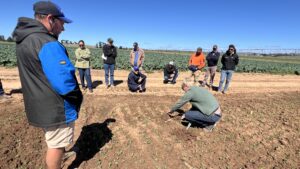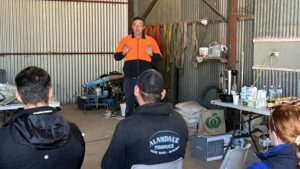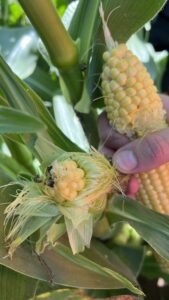Soil biology aids in rebuild after rain events in Bathurst and Cowra
The ‘Building Biosecurity Capacity and Resilience within the NSW Vegetable Industry’ project, funded by the NSW Government’s Storm and Flood Industry Recovery Program, brought together scientists and advisors from interstate and across Bathurst and Cowra regions in mid April 2024.
Day 1 Alandale Produce in Bathurst.
Flooding due to extreme or prolonged rain events can wreak havoc for vegetable growers.
In addition to direct crop damage and loss, excess water can also increase biosecurity risks through impacts on pest and disease pressures, changes in soil and water quality, and the movement of biological and other hazards with soil and water.
Attendees saw first-hand the benefits to soil biology and structure where the Alandale Produce owners, Val and Sam Micallef have integrated cover-cropping into their rotations.

Stephanie Tabone and Kelvin Montagu from Applied Horticultural Research explained how cover cropping can help to improve soil structure, increase organic matter and biological activity, water infiltration and water holding capacity.
This can reduce the risk of losing topsoil and support a more rapid return to cropping after flood events.
Key take homes included:
- consider what to plant as part of your cover crop,
- why you are planting it and
- how you will terminate the crop.
A cover crop will be unique to each situation.
Leigh James from AgriWest discussed options for management of Clubroot (which can be spread via movement of soil), including managing soil pH, mapping of paddocks and rotating crops.

John Duff and Praise Tadle from Queensland Government’s Department of Fisheries and Agriculture demonstrated the impact of Fall armyworm (FAW) on sweetcorn, sorghum and maize crop development with affected samples. The key take-home messages:
-
-
- the importance of destructive sampling to truly know the numbers of FAW in the crop (they can hide!),
- where the FAW come from (the cycles of flying, burrowing and emergence), and
- the importance of rotating chemistry to reduce the risk of resistance.
-
In the farm blocks, IPM specialist Andy Ryland discussed the role of beneficial insects and pesticide compatibility for managing pests. There were plenty of beneficials on show.
A very big thanks to Sam and Val Micallef for hosting the event.
Day 2 at Simplot, Cowra

A big thank you to Evan Brown and his team at Simplot for hosting the ‘Building Biosecurity Capacity and Resilience within the NSW Vegetable Industry’ field day in Cowra. Simplot grow corn, beetroot, broccoli, cauliflower and other vegetables in the region. Attendees heard how flooding had impacted the farm, and other growers in the region, including loss of riverbank, spray infrastructure under water, and soil compaction as large volumes of water sat for periods of time.
The Soil Wealth team at AHR illustrated that cover crops are called that for a reason – terminated cover crops provide protection against erosion and loss of soil after rains as a ‘brown’ fallow.
And, like the Hungry, Hungry Caterpillar book, Fall armyworm also likes to eat a devastating amount. John Duff and Praise Tadle from Queensland Government’s Department of Fisheries and Agriculture brought along samples of maize, sorghum and sweet corn that had been planted at the same time – sweet corn was much more stunted that the other crops, less able to recover from feeding damage.
 Fall armyworm does like to hide – it can burrow in corn cobs and plants making it difficult to find. John and Praise stressed the importance of destructive sampling to get a true indication of numbers and Evan Brown provided extensive insight into how he is managing FAW across Simplot’s farm’s throughout the country, including monitoring and recording pests more broadly, not just FAW. At Cowra, whilst FAW was an issue, the company’s integrated management program was rising to the challenge.
Fall armyworm does like to hide – it can burrow in corn cobs and plants making it difficult to find. John and Praise stressed the importance of destructive sampling to get a true indication of numbers and Evan Brown provided extensive insight into how he is managing FAW across Simplot’s farm’s throughout the country, including monitoring and recording pests more broadly, not just FAW. At Cowra, whilst FAW was an issue, the company’s integrated management program was rising to the challenge.
Thank you to Evan and Ben from Simplot for hosting us, to the QDAF FAW research and extension team, Andy Ryland of IPM Crop Services, and Stephanie Tabone, Sophia Thach and Kelvin Montagu from AHR. The SFIRP project is coordinated by Marguerite White of ICD Project Services for AUSVEG. Similar events will be held on the north coast during April and May.
https://ausveg.com.au/event/nambucca-heads-effective-pest-and-disease-management-on-your-farm/
https://ausveg.com.au/event/bucca-effective-pest-and-disease-management-on-your-farm/
The Building Biosecurity Capacity and Resilience within the NSW Vegetable Industry Project is funded by the Australian and NSW Government’s Storm and Flood Industry Recovery Program with support from AUSVEG. The National fall army worm innovation system for the Australian vegetable industry project (VG22006) is funded by Hort Innovation using the vegetable research and development levy, Queensland Department of Agriculture and Fisheries, the Victorian Department of Energy, Environment and Climate Action and funds from the Australian Government. This event is also supported by AgriWest, Applied Horticultural Research (AHR) through the Soil wealth ICP project (MT22004), NSWDPI Plant Health Diagnostics Service, Integrated Pest Management Consulting and Local Land Services.

